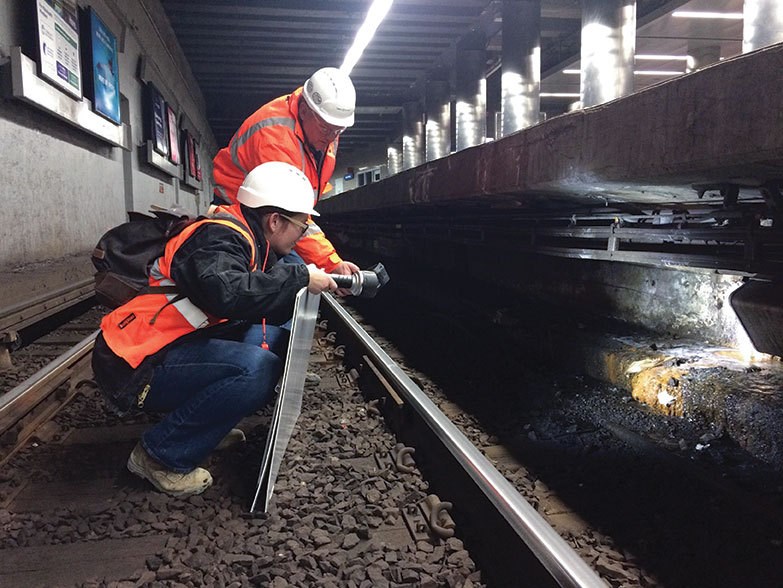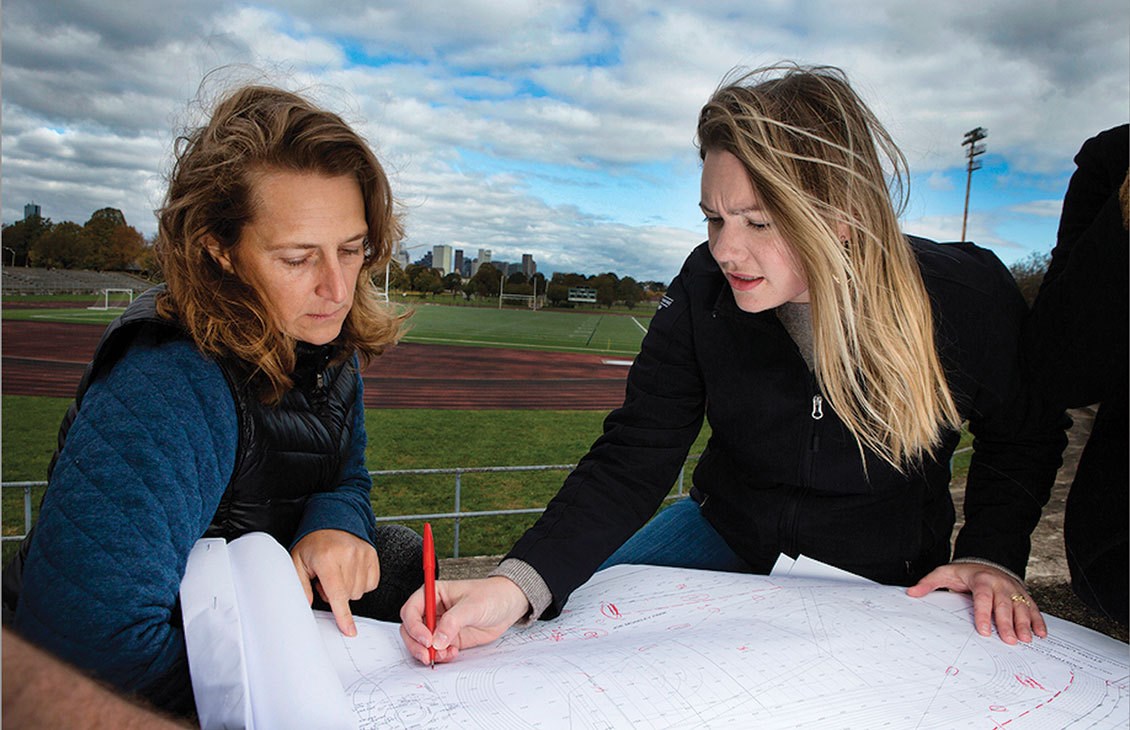Hurricane Katrina Inspired Julie Eaton Ernst ’14, ’17 to Alter Her Course

Civil engineer Julie Eaton Ernst '14, '17 has helped fortify much of Boston's waterfront and infrastructure against extreme weather.
10/01/2023
By Katharine Webster
Julie Eaton Ernst ’14, ’17 was one of the lucky ones. She evacuated from New Orleans before Hurricane Katrina overwhelmed the levees in August 2005, flooding the city, killing an estimated 1,833 people on the Gulf Coast, displacing millions more and causing $161 billion in damage.
Several years later, Eaton Ernst decided to study geotechnical engineering at UMass Lowell because, she says, “I wanted to design levees that won’t fail.”
Now, she works with the city of Boston and beyond to adapt the built environment to climate change and to prepare for extreme storms, like Hurricane Katrina.
As a licensed professional civil engineer and founder of the climate resilience strategic initiative at engineering firm Weston & Sampson, she and her team of 20-plus professionals have worked on much of Boston’s waterfront and infrastructure. Their projects include helping redesign Moakley Park and evaluating the
MBTA’s rapid transit lines and stations, to protect them from extreme weather and the effects of climate change, including rising seas.
Working for the Resilient Massachusetts Action Team, she developed statewide resilience design standards for the built environment, and she also wrote Boston’s flood control design guidance.
And all because Katrina devastated New Orleans just as she was starting her freshman year at Tulane University—as a musical theater major.
An Ill Wind Blows
On the day of Eaton Ernst’s freshman orientation at Tulane, the college president called a general assembly.
Hurricane Katrina was bearing down on the city, and the president told the freshmen they had three choices: They could return home with their parents, they could leave on their own, or they could evacuate on a fleet of buses headed for Jackson State University in Jackson, Mississippi, 185 miles north.
Eaton Ernst’s family had hugged her goodbye and prepared to head home to Concord, Massachusetts, reassured because New Orleans locals had told them the approaching hurricane was “normal, like the nor’easters we get in New England,” she recalls.
Eaton Ernst grabbed her laptop and backpack and boarded one of the buses heading for Jackson State. After hours on roads clogged with evacuees, the Tulane students arrived at 2 a.m. and bedded down on the floor of the campus gym.
Just three hours later, all their cellphones started ringing as their panicked families called: Katrina had just been upgraded to a Category 5 hurricane.
Eaton Ernst’s parents said they were driving to fetch her, and when they got to Mississippi, they took two of her classmates north with them, just out of the storm’s reach. Not long after, the gym at Jackson State flooded.
Eaton Ernst spent her “hurricane semester” at Boston College while dorming in cardinal’s quarters at the Roman Catholic Archdiocese of Boston. She followed the news of Hurricane Katrina and its aftermath from afar, but nothing prepared her for what she saw when she
returned to Tulane for the spring semester.
The Wreckage
“You saw the line of black mold throughout the city that marked the height of the flooding, and you saw the body counts of humans and pets spray-painted on the doors, and there was an Army National Guard tank on the street,” she says. “I said, ‘Dad, you can’t leave me here!’”
She felt better when they reached the campus. New Orleans Saints football players welcomed the students and helped them move into newly repaired dorms. “The generosity and resilience of people was something that really came through,” she says. “There was a commitment to that spirit of New Orleans.”
She only lasted a semester at Tulane. Months after the water receded, the air was contaminated with all that Katrina had left behind: mold, sewage, hazardous chemicals and decomposing plants and animals. Eaton Ernst, who had previously suffered from mild asthma, went to the hospital emergency room nearly once a week because she couldn’t breathe.
Back home in late May, doctors told her that if she returned to New Orleans, she would be dead before she was 25. That ended her musical theater dreams: “If I couldn’t breathe, I couldn’t sing.”
By that time, though, she was obsessed with figuring out how “government at every level had failed” New Orleans. She transferred to the University of Rochester in Rochester, New York, where she majored in political science and wrote research papers on every aspect of that failure.
“I wanted to know how this could happen in America — this level of devastation, the stories people were telling me about their loved ones, about their homes, about how they were unable to evacuate,” she says. “I decided that I wasn’t giving up on New Orleans … and I dedicated all of my studies to understanding what happened.”
Eaton Ernst was most outraged to learn that, after the Federal Emergency Management Agency ran a simulation test for a Category 3 hurricane’s effects on New Orleans in 2004, state and local authorities failed to prepare for a severe storm, and the U.S. Army Corps of Engineers failed to make needed upgrades to the levees and other infrastructure.
“They knew the levees were going to fail,” she says. “They absolutely knew the level of devastation that was going to happen. They prepared all these action items—and nothing happened.”

Julie Eaton Ernst review plans at Boston waterfront.
Engineering Better Outcomes
When she couldn’t find a political solution, Eaton Ernst turned her attention to the technical failures. She took engineering classes at Rochester and loved them. “There was a right answer. It took away the emotional aspect,” she says.
She graduated in 2009 and worked hard at multiple jobs to pay down her student debt. But after a couple of years, she decided she needed to go back to school. She approached the Civil and Environmental Engineering Department at UMass Lowell about her goal of earning a master’s degree in geotechnical engineering. She took undergraduate and graduate classes simultaneously for two years.
“UMass Lowell, bar none, has the best education,” she says. “The professors truly care and want to make sure students are ready to go out into the world and be successful.”
She went on her first “date” with her future husband, Jonathan Ernst ’14, ’18 (also a geotechnical engineer), to a career fair in Boston, where she met representatives from Weston & Sampson. The firm hired her, and she worked full time while completing her master’s degree.
No sooner had she finished, in 2017, than she persuaded the company’s board of directors to start a new strategic initiative on climate resilience: “I told them that we had to focus on this, because if we didn’t, everything we were designing and building wouldn’t last—and that posed a risk to our firm and its reputation, not just to public health and safety.”
In the six years since, Eaton Ernst has grown her team — and they have become leaders in the field. She was the first engineer to evaluate the MBTA for climate and extreme weather risks, and her team was on call whenever severe weather could necessitate station closures and deployment of the T’s floodgates.
They worked with landscape architects on the redesign of Moakley Park, the largest on Boston’s waterfront, to include flood barriers and enhanced stormwater management, all while maintaining and even improving people’s access to the waterfront. They were selected to evaluate all 8,400 state-owned buildings, lands and structures, from prisons and nursing homes to parks, for potential climate impacts.
Closer to home, where she, Ernst and their daughter live in Lowell, she’s working on the city’s urban forest master plan. The goal: to evaluate and strategically increase Lowell’s tree canopy to mitigate heat islands and improve public health.
Eaton Ernst also chairs the Climate Change and Air Committee for the Environmental Business Council of New England and serves on the external advisory board for UMass Boston’s Sustainable Solutions Lab.
In 2022, she received the national Young Professional of the Year Award from the American Council of Engineering Companies. And she gave the inaugural Francis Lecture on the Built Environment at UMass Lowell.
She says that if the country wants to prevent the devastation of another Hurricane Katrina, then cities, states and the federal government need to invest in infrastructure improvements in tandem with the communities that are most affected.
“Communities of color and low-income neighborhoods have borne the biggest impacts of environmental injustices, including climate change, but we can work toward addressing these inequities in our solutions,” she says.
“It’s an all-hands-on-deck situation. This is creating opportunities for so many people to be involved in changing our environment and to have a say in what we want our future to look like.”
